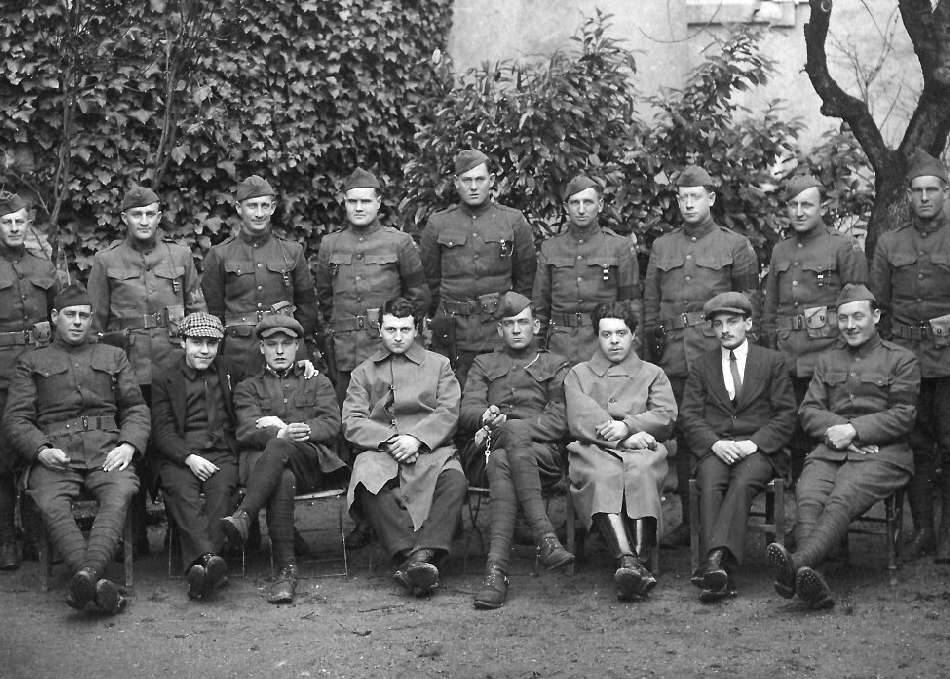
World War I: American AEF--Significant Numbers

Figure 1.-- Here we see a group of AEF Doughboys from the 80th Division. We believe they are MPs, notice the arm bands and whistlkes. There seem to be soime French youths working with them. One of the youths is Fernand Taizieres 25 Faubourg de Loire La Charite (Nievre). MPs worked behind the front lines. As aresultvthere was much more interaction with civilians. The youths and young men are presumably students with some English-language skills who helped the MPs communicate with the local civilian population. The 80th Division was organized (August 5, 1917) and trained at Camp Lee, New Jersey. Because of the origins of many of the men (Pennsylvania, Virginia, and West Virginia), it became known as the Blue Ridge Division. The Division reached France (June 8, 1918). They trained with the British Third Army and joined forces on the front lines near the Artois sector. They first saw heavy action in the Somme Offensive as the Allied war-winning Hundred Day Offensive began (August-September 1918).
|
|
Significant numbers of American soldiers did not begin to arrive in France for some tome after the United states declared war. This was because the United States, unlike European countries, did not have a large army in being that they could immediately send over. The American standing prifessional army was only 127,500 officers and men. Pershing immediately went to France after his appontment (May 1917). He did not have an arnmy to take with him. The task of creating an army was assigned to others. The first troops, a mere 14,000 men arrived (June 1917). They were called 'Doughboys', the origins of the term sre still debated. For several months only a trickle of American followed. The numbers gradually increased. The 1st Division was the first American Division to be moved up to the front (October 1917). This was the only American division composed of experienced regular Army soldiers. It was thus the first American combat division to arrive in France. They were deployed near Nancy. Throughout the rest of 1917 and early-1918, American divisions were primarily deployed to support French and British units who soon hard pressed to hold the line against the German Spring Offensive. The 1 million man figure was reached (May 1918) and more troops were on the way. Large numbers of troops arrived monthly. In the peak month over 300,000 Americans arrived in France (July 1918). This was more than doublke the pre-War size of the U.S. Army. Pershing finally had the numbers he needed to opperate independently from the British and French. About half of the AEF had been moved up to the front line at this time. They plyed an important role in stoping the German Spring Offensive. And they soon had the combt experience needed to play a central role in the Allied war-winning 100 Day Offensive. By the time of the Armistics more than 2 million Americans had arrived in Europe (November 1918). And more than 40,000 civilians were serving in various capacities such as ambulance drivers. Nearly 200,000 were Afro-Americans. Most of the AEF was deployed to France, but a few were also sent to northwestern Russia and northern Italy. Another 2 million Americans were still training in the States. Few Germans who had to face the AEF in combat were aware that such a massive force had not even arrived yet. The NAZIs who manufactured the 'stab in the back' charge never mentioned those 2 million additional Americans yet to even arrive in France.
HBC

Navigate the Boys' Historical Clothing Web Site:
[Return to Main AEF page]
[Return to Main American Army page]
[Return to Main America's enter's World War I page]
[Introduction]
[Activities]
[Biographies]
[Chronology]
[Clothing styles]
[Countries]
[Bibliographies]
[Contributions]
[Essays]
[FAQs]
[Glossaries]
[Images]
[Links]
[Registration]
[Tools]
[Boys' Clothing Home]
Created: 2:29 AM 4/26/2008
Last updated: 2:30 AM 4/26/2008



